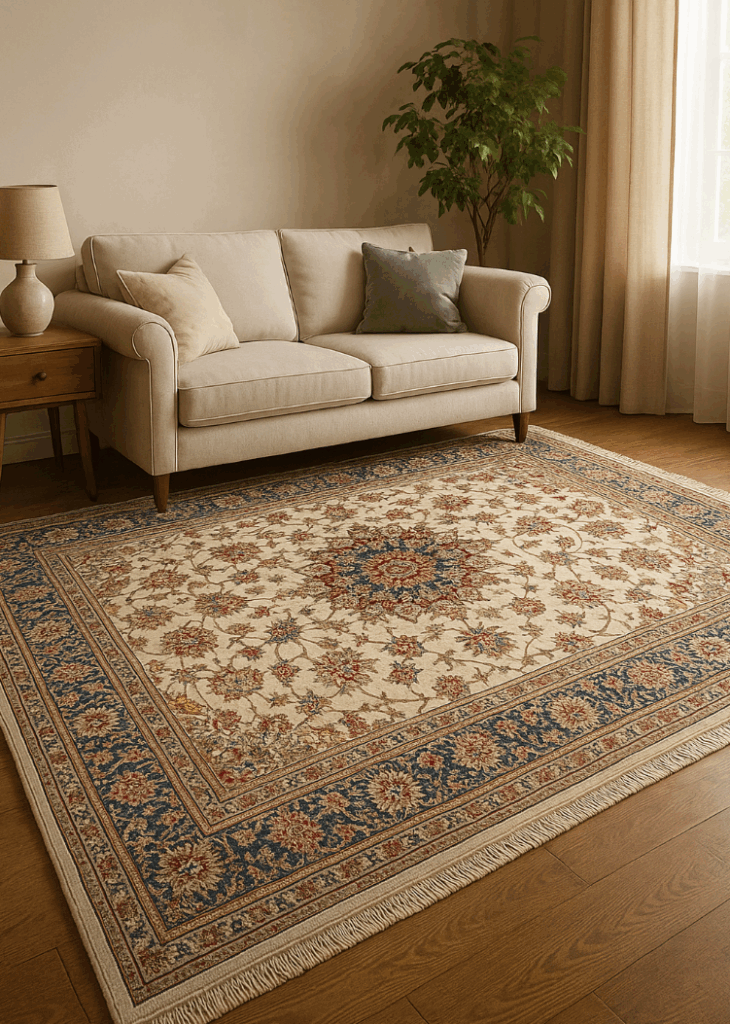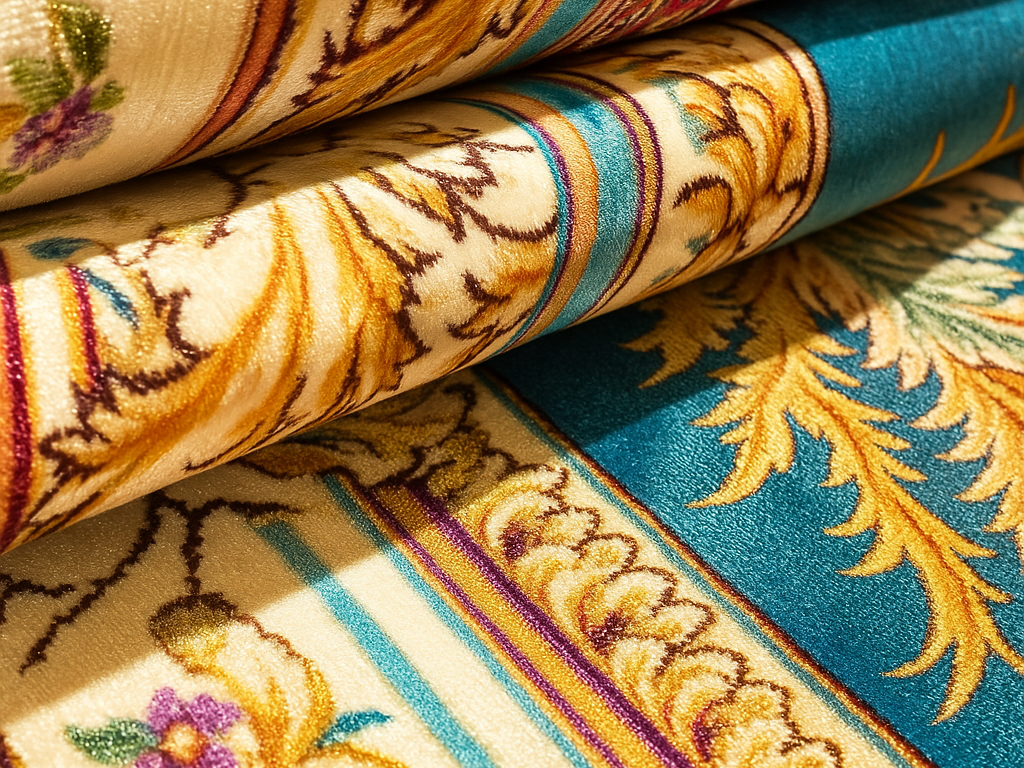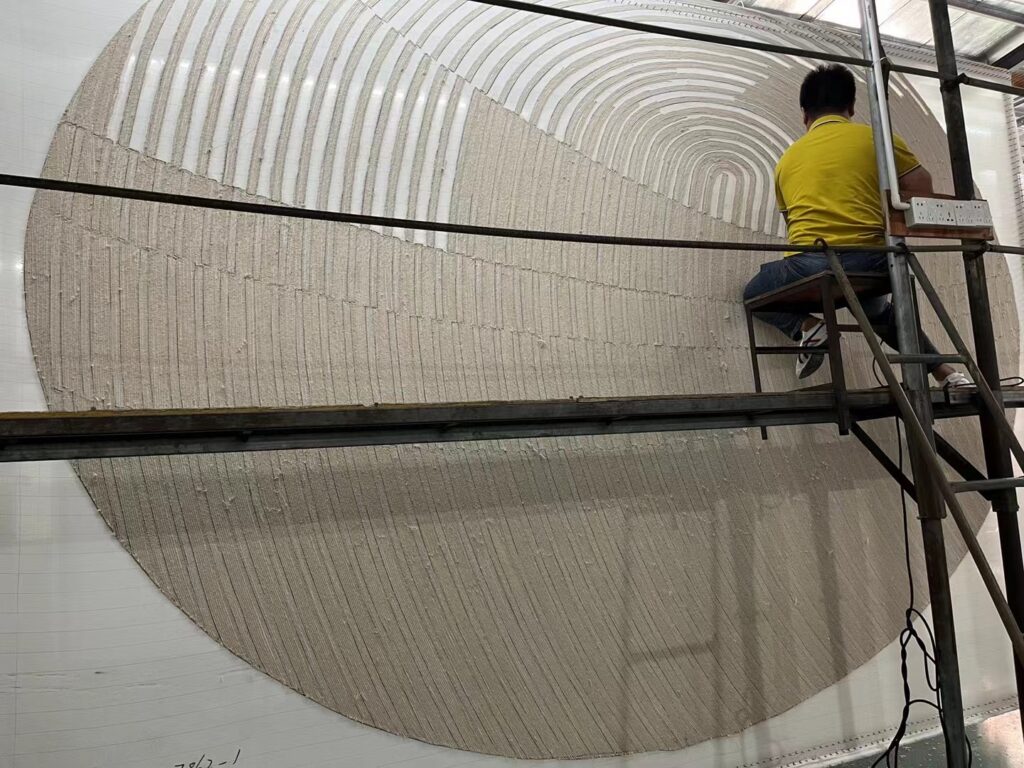Silk rugs are more than just floor coverings—they are masterpieces woven with history, artistry, and a touch of luxury. For centuries, these intricate textiles have adorned palaces, temples, and homes, symbolizing status, culture, and refined taste. But what exactly is a silk rug, and why does it command such reverence? Let’s unravel the threads of this ancient craft.

What Is a Silk Rug?
A silk rug is a textile floor covering handknotted or tufted using natural silk fibers harvested from silkworm cocoons. Unlike wool or cotton rugs, silk’s unique protein structure gives these rugs a luminous sheen, featherlight weight, and astonishing durability when cared for properly. The finest silk rugs are hand-knotted, a labor-intensive process where each thread is individually tied to a foundation, creating dense, detailed patterns that can last generations.
Silk’s origins trace back to ancient China, where it was reserved for emperors and nobility. Today, silk rugs remain synonymous with luxury, often costing thousands of dollars due to the meticulous craftsmanship and rarity of high-quality silk.
History of Silk Rugs
The story of silk rugs begins over 4,500 years ago in China’s Yangshao culture, where silk production (sericulture) was a closely guarded secret. Legend credits Empress Leizu with discovering silk when a cocoon fell into her tea, unraveling its delicate thread. By the Han Dynasty (206 BCE–220 CE), silk had become a currency along the Silk Road, spreading weaving techniques to Persia (modern-day Iran), India, and Turkey.
Persian silk rugs, particularly from cities like Kashan and Qom, became legendary during the Safavid Empire (1501–1736). These rugs featured intricate floral motifs and arabesques, often dyed with natural pigments like pomegranate skins or indigo. Meanwhile, Mughal emperors in India commissioned silk-and-wool blends, blending Persian designs with Hindu symbolism.
In the 19th century, European demand for “Oriental carpets” surged, turning silk rugs into global heirlooms. Today, antique silk rugs from this era fetch millions at auctions, like the $33.7 million Clark Sickle-Leaf carpet sold in 2013.
How to Make a Silk Rug
Creating a silk rug is an intricate process that combines traditional craftsmanship with artistic expression. There are two primary methods for making silk rugs: hand-knotted and hand-tufted. Each technique offers distinct characteristics, influencing the rug’s texture, durability, and overall aesthetic.
Hand-Knotted Silk Rugs
Hand-knotting is a time-honored technique that involves tying individual knots to create the rug’s pile. This method is renowned for producing highly durable and intricate designs.
1. Silk Preparation
The process begins with harvesting silk fibers from silkworm cocoons. These fibers are then spun into threads suitable for weaving.
2. Design Mapping
Artisans draft detailed patterns, often on graph paper, to guide the knotting process. Each square represents a single knot, ensuring precision in the final design.
3. Loom Setup
A loom is prepared by stretching vertical threads (warp) tightly across the frame. This foundation supports the intricate knotting process.
4. Knotting Process
Using techniques like the Persian (Senneh) or Turkish (Ghiordes) knot, artisans tie individual knots around the warp threads. The density of knots, measured in knots per square inch (KPSI), determines the rug’s detail and durability.
5. Finishing Touches
After knotting, the rug undergoes trimming to ensure an even pile height. It is then washed to enhance luster and stretched to maintain shape.
Hand-knotted silk rugs are prized for their longevity and intricate designs, often becoming family heirlooms passed down through generations.
Tufted Silk Rugs

Tufting is a more contemporary technique that allows for quicker production while still offering aesthetic appeal.
1. Canvas Preparation
A primary canvas is stretched over a frame, and the desired design is outlined on its surface.
2. Tufting Process
Using a tufting gun, artisans punch strands of silk yarn into the canvas, following the outlined design. This creates the rug’s pile.
3. Securing the Pile
Once tufting is complete, a layer of latex adhesive is applied to the back to hold the yarns in place. A secondary backing material, such as canvas or felt, is then attached for added stability.
4. Finishing
The rug is sheared to achieve a uniform pile height and may undergo additional processes like washing or carving to enhance its appearance.
Types of Silk Rugs
Silk rugs come in various styles, each reflecting the unique heritage of its region:
- Persian Silk Rugs (Iran): Renowned for curvilinear designs, medallions, and garden motifs. Kashan and Qom rugs often feature silk pile on silk foundations, achieving a painterly effect.
- Chinese Silk Rugs: Symbolism reigns here: dragons denote power, peonies symbolize wealth, and clouds represent heaven. Imperial rugs from the Qing Dynasty are museum staples.
- Indian Silk Rugs (e.g., Kashmiri): Blend Persian aesthetics with Indian flora/fauna. Many use pashmina (cashmere-silk blends) for added softness.
- Turkish Silk Rugs (Hereke): Hereke rugs, crafted for Ottoman sultans, boast geometric precision and often incorporate gold or silver threads.
- Modern and Machine-Made Silk Rugs: Affordable alternatives using machine-looms and blended fibers (silk/wool or silk/viscose) mimic handwoven beauty at lower costs.
How to Clean a Silk Rug
Cleaning a silk rug requires precision—its delicate fibers demand gentle methods to avoid irreversible damage. Below is a step-by-step guide tailored to preserve both color and texture.
Daily and Weekly Care
- Vacuuming: Use a handheld vacuum or a upright vacuum without a beater bar on the lowest suction setting. Glide lightly over the surface to avoid pulling threads. Flip the rug every 3–4 months to vacuum the back, dislodging embedded dust.
- Shake It Out: For small rugs, take them outdoors and gently shake them to remove loose debris. Avoid vigorous shaking, as this can stress the foundation.
Tackling Spills and Stains
- Blot, Don’t Rub: Use a microfiber cloth or white paper towel to absorb liquids immediately. Rubbing spreads stains and frays fibers.
- DIY Cleaning Solution: Mix 1 teaspoon of mild dish soap (like Dawn) with 2 cups of cool water. Test on a hidden corner first.
- Spot Treatment: Dab the stain with the solution using a soft sponge. Rinse with a damp cloth and blot dry. For oil-based stains (e.g., makeup), sprinkle cornstarch, let sit for 15 minutes, then vacuum.
Deep Cleaning
- Professional Help: Silk rugs should be professionally cleaned every 12–18 months. Experts use immersion washing in pH-neutral solutions and cold water to prevent dye bleeding. Avoid steam cleaning—heat weakens silk fibers.
- At-Home Refresh: For minor odors, sprinkle baking soda lightly, wait 30 minutes, then vacuum. Never soak or machine-wash silk rugs.
Drying Tips
- Lay the rug flat on a clean, dry towel away from direct sunlight. Use a fan to circulate air but avoid heat sources.
Pro Tip: Red wine or ink stains? Dab with a cloth dipped in club soda—its effervescence lifts pigments without harsh chemicals.
How to Maintain a Silk Rug
Maintaining a silk rug goes beyond cleaning—it’s about preserving its structural integrity and aesthetic appeal. Here’s how to protect your investment:
Preventive Care
- Avoid Direct Sunlight: Prolonged UV exposure fades colors. Use sheer curtains or UV-blocking window film. Rotate the rug every 6 months to ensure even fading.
- Limit Foot Traffic: Silk fibers are delicate. Place rugs in low-traffic zones like bedrooms or formal areas.
- Use Rug Pads: Non-slip, breathable pads (felt or rubber) prevent shifting, reduce friction, and cushion fibers against wear.
Environmental Control
- Humidity Management: Silk thrives in 40–60% humidity. Use dehumidifiers in damp climates to prevent mold; add humidifiers in arid regions to avoid brittle fibers.
- Temperature Stability: Avoid placing rugs near radiators, fireplaces, or AC vents. Extreme heat dries silk, while cold can stiffen threads.
Professional Inspections
- Have a rug specialist assess your silk rug every 2–3 years. They’ll spot early signs of moth damage, weak knots, or dye bleeding missed during routine care.
Proper Handling
- Lifting Correctly: Never drag a silk rug. Roll it loosely with the pile facing inward, and carry it horizontally to prevent stress on the foundation.
- Avoid Sharp Objects: Keep high heels, pet claws, and furniture legs away. Use felt pads under chair/table legs to distribute weight.
Storage Guidelines
- Roll, Don’t Fold: Folding creases silk fibers permanently. Roll the rug with acid-free paper inside to wick moisture.
- Avoid Plastic: Store in a cotton cloth or breathable fabric to prevent trapped moisture. Add cedar blocks to deter moths.
Pro Tip: If storing long-term, unroll and air the rug annually in a shaded, dry space to prevent mustiness.
Conclusion
Silk rugs are more than decor—they’re heirlooms woven with history. By understanding their origins, craftsmanship, and care, you can preserve their beauty for decades. Whether displayed in a living room or gallery, these pieces demand respect and a gentle touch.
FAQs
Q1: Can silk rugs handle heavy foot traffic?
A: No. Place them in low-traffic areas (bedrooms, formal dining rooms) to minimize wear.
Q2: How often should I professionally clean my silk rug?
A: Every 1–2 years, depending on use.
Q3: Are silk rugs pet-friendly?
A: Not ideal. Claws can snag threads, and pet accidents may stain.
Q4: Can sunlight fade silk rugs?
A: Yes. Use UV-blocking window film or keep away from direct sun.
Q5: How do I identify a real silk rug?
A: Rub the surface—real silk feels cool and slightly uneven. Burn test a thread (if permitted); genuine silk smells like burnt hair and turns to ash.


